Статьи журнала - International Journal of Intelligent Systems and Applications
Все статьи: 1126
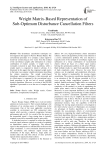
Weight matrix-based representation of sub-optimum disturbance cancellation filters
Статья научная
The disturbance cancellation techniques are investigated in this paper for Passive Bistatic Radars. The conventional procedure is to compute a clean signal by iteratively constructing an error vector from the residual of the surveillance samples after subtraction of a linear combination of clutters samples. A weight vector is eventually extracted in pure block algorithms, while a weight matrix is computed in iterative schemes. It is illustrated in this paper that the computed weight matrix in the latter case contains valuable information describing the clutters properties. The weight matrix-based disturbance attenuation technique is then innovated and its effectiveness is compared to the conventional error-based procedure in the test bed of several available iterative algorithms. Moreover, a revision of the FBLMS algorithm is presented to cover the case of complex input signals.
Бесплатно
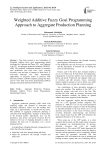
Weighted Additive Fuzzy Goal Programming Approach to Aggregate Production Planning
Статья научная
This study presents a new formulation of Weighted Additive fuzzy goal programming model developed by Yaghoobi and Tamiz [21]. and Yaghoobi et al [22] for aggregate production planning (WAFGP-APP), The proposed formulation attempts to minimize total production and work force costs, carrying inventory costs and rates of changes in Work force. A real-world industrial case study demonstrates applicability of proposed model to practical APP decision problems. LINGO computer package has been used to solve final crisp linear programming problem package and getting optimal production plan.
Бесплатно
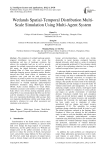
Wetlands Spatial-Temporal Distribution Multi-Scale Simulation Using Multi-Agent System
Статья научная
The simulation of wetland landscape spatial-temporal distribution not only can reveal the mechanisms and laws of landscape evolution, but achieve the sustainable land use as well as provide supports for wetland conservation and management. In this report, the inland freshwater wetlands in the Sanjiang Plain of China were selected for wetland landscape changing process simulation studies. Results showed that both visual effects of simulation and prediction were good and the total accuracy co-efficiency of points to points was also significantly high (above 82%), which demonstrated the feasibility and effectiveness of wetland landscape spatial-temporal distribution simulation using Multi-Agent System (MAS). Scales exerted influence on visual effects, simulation accuracies and statistics of landscape index. Scale effects were obvious during simulation process using MAS. It was demonstrated that 60m was the best scale for simulation. It was shown that contagion index lines were exponential distribution while accuracy lines were lognormal distribution with the scale rising, which provided a reference for scale effect assessment and simulation scale selection.
Бесплатно
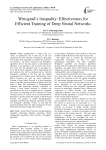
Winograd’s inequality: effectiveness for efficient training of deep neural networks
Статья научная
Matrix multiplication is widely used in a variety of applications and is often one of the core components of many scientific computations. This paper will examine three algorithms to compute the product of two matrices: the Naive, Strassen’s and Winograd’s algorithms. One of the main factors of determining the efficiency of an algorithm is the execution time factor, how much time the algorithm takes to accomplish its work. All the three algorithms will be implemented and the execution time will be calculated and we find that Winograd’s algorithm is the best and fast method experimentally for finding matrix multiplication. Deep Neural Networks are used for many applications. Training a Deep Neural Network is a time consuming process, especially when the number of hidden layers and nodes is large. The mechanism of Backpropagation Algorithm and Boltzmann Machine Algorithm for training a Deep Neural Network is revisited and considered how the sum of weighted input is computed. The process of computing the sum of product of weight and input matrices is carried out for several hundreds of thousands of epochs during the training of Deep Neural Network. We propose to modify Backpropagation Algorithm and Boltzmann Machine Algorithm by using fast Winograd’s algorithm. Finally, we find that the proposed methods reduce the long training time of Deep Neural Network than existing direct methods.
Бесплатно
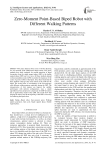
Zero-Moment Point-Based Biped Robot with Different Walking Patterns
Статья научная
This paper addresses three issues of motion planning for zero-moment point (ZMP)-based biped robots. First, three methods have been compared for smooth transition of biped locomotion from the single support phase (SSP) to the double support phase (DSP) and vice versa. All these methods depend on linear pendulum mode (LPM) to predict the trajectory of the center of gravity (COG) of the biped. It has been found that the three methods could give the same motion of the COG for the biped. The second issue is investigation of the foot trajectory with different walking patterns especially during the DSP. The characteristics of foot rotation can improve the stability performance with uniform configurations. Last, a simple algorithm has been proposed to compensate for ZMP deviations due to approximate model of the LPM. The results show that keeping the stance foot flat at beginning of the DSP is necessary for balancing the biped robot.
Бесплатно
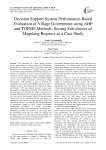
Статья научная
The increasing of village grants provider growth opportunities for villages every year. The Reliable performance of village governance is the main factor that determines the development of a village. In Secang, there are still many rural governance performances that are not optimal yet, therefore we need a system of performance evaluation of the village government. Decision support systems with a combination of AHP and TOPSIS models can be used to help evaluating performance village Government. AHP method is used to perform the weighting of the criteria and TOPSIS methods to make a ranking system of the performance evaluation of village government. AHP was chosen because it has many advantages of computation weighting while TOPSIS was efficient and able to measure the relative performance in a simple mathematical form. One advantage of the system that was built is the dynamic nature of the assessment criteria used for the calculation process, with menus for assessment criteria period the user can add or reduce the assessment criteria in accordance with the requirements or regulations. Output of DSS Village Government Performance Evaluation is village government performance ratings that can be used as a consideration in determining rewards and assistance to the village from the sub-district. From the test results on ranking and prototype, 86.67% of users agree that the prototype can be implemented and used to evaluate the performance of village government in the Secang sub-district.
Бесплатно

